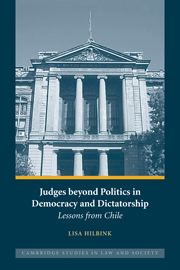Book contents
- Frontmatter
- Contents
- Acknowledgments
- Introduction
- 1 The Judiciary, the Rule of Law, and Democracy: Aspirations and Impediments
- 2 The Institutional Construction of the Judicial Role in Chile
- 3 Conservative Activism in the Heyday of Democracy, 1964–1973
- 4 Legitimizing Authoritarianism, 1973–1990
- 5 Continuity and Change after the Return to Democracy, 1990–2000
- 6 Conclusions and Implications
- Appendix A Orienting Information on Chilean Law and Courts
- Appendix B List of Interviewees (alphabetical by category)
- References
- Index
4 - Legitimizing Authoritarianism, 1973–1990
Published online by Cambridge University Press: 08 January 2010
- Frontmatter
- Contents
- Acknowledgments
- Introduction
- 1 The Judiciary, the Rule of Law, and Democracy: Aspirations and Impediments
- 2 The Institutional Construction of the Judicial Role in Chile
- 3 Conservative Activism in the Heyday of Democracy, 1964–1973
- 4 Legitimizing Authoritarianism, 1973–1990
- 5 Continuity and Change after the Return to Democracy, 1990–2000
- 6 Conclusions and Implications
- Appendix A Orienting Information on Chilean Law and Courts
- Appendix B List of Interviewees (alphabetical by category)
- References
- Index
Summary
The dissolution or mass resignation of the Supreme Court would have been better from the point of view of clarifying what was happening in Chile. At least it would have been clear to the people, clear in the conscience of the country, and clear internationally. I think that one of the tremendous things that happened in Chile is that the dictatorship cloaked itself nationally and internationally with the legality that the judiciary gave it.
Chilean Human Rights LawyerWhen the generals overthrew the Allende government and seized power on September 11, 1973, they did so in the name of the rule of law (el estado de derecho). In its first official statement justifying the coup, Edict No. 5 (Bando No. 5), the governing junta declared that the Allende administration had “placed itself outside the law on multiple occasions, resorting to arbitrary, dubious, ill-intentioned, and even flagrantly erroneous [legal] interpretations;” and had “repeatedly failed to observe the mutual respect which one power of the state owes to another.” For these reasons, the Allende government had “fallen into flagrant illegitimacy,” and the armed forces had “taken upon themselves the moral duty … of deposing the government, … [and] assuming power” with the objective of reestablishing “normal economic and social conditions in the country, with peace, tranquillity, and security for all.”
At first, many Chileans believed that the military was intervening on a temporary basis and would call elections within a few months.
- Type
- Chapter
- Information
- Judges beyond Politics in Democracy and DictatorshipLessons from Chile, pp. 102 - 176Publisher: Cambridge University PressPrint publication year: 2007



